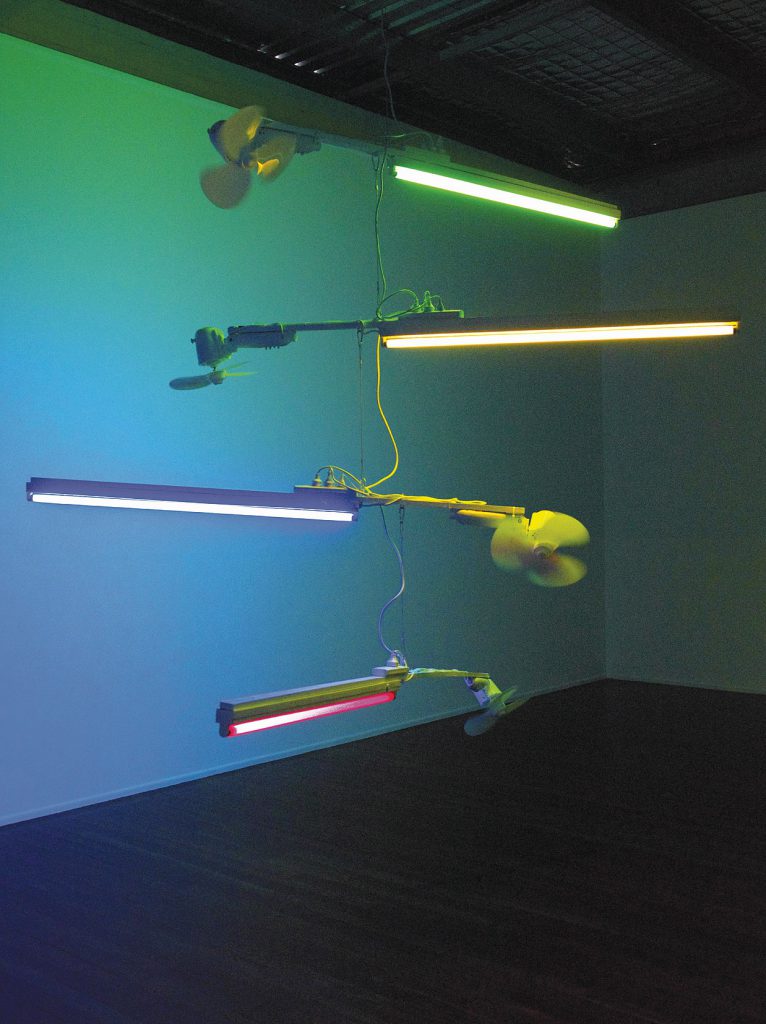Ross Manning
Spectra
Milani Galleries, Brisbane
9–25 February 2012

At the time of writing, some Android users were eagerly awaiting the over-the-air release of Ice Cream Sandwich — an operating system update for their mobile phones and tablets. One of the features most anticipated in the update is the enhanced support for live wallpapers, owing to a significant boost in hardware acceleration. Live wallpapers serve as a background to the user’s device and feature not only animation, but also reactivity to the accelerometer, GPS and touch screen. A cursory glance at online repositories of live wallpapers shows that, amongst the animated waterfalls, kittens, sunrises and bikini models, a growing ‘genre’, and one with the greatest overall popularity, is ‘Abstract’. Typically, the generic features of the live abstract wallpapers are bright, neon colours, ambient glow effects, and high levels of contrast. Conventionally, the names of these themes feature words commonly associated with the study of light: ‘Wave’, ‘Stream’, ‘Beam’, and ‘Spectrum’ being popular examples.
In two of Milani Gallery’s three spaces, Brisbane-based artist Ross Manning installed very different, but similarly ambient and animated, live wallpapers.
Entering the space, the impressively scaled Spectra 2012 mobile of fluorescent lights and fans hung from the ceiling, washing the walls with pale light. In both scale and kinetic movement, associations with Alexander Calder and Olafur Eliasson are easy to come to, however, Michel Gondry’s lo-fi effects might be a more useful touchstone. Like Android’s live wallpapers, Manning’s work is also decidedly open-source — transparency of materials and construction being hallmarks of his work. Spectra’s carabineers, zip-ties and network of power boards were exposed to the viewer. On the lowest tier of the mobile the Radiata Pine beam showed the first signs of strain — a perceptible bow arced toward the floor.
Endless Sheet 2010 similarly engages with moving light. A scroll of arbitrarily punctured paper rolled endlessly over a bed of overhead projectors, resulted in wildly random circles of light being cast on the smaller of the two gallery’s walls. The ‘conveyor belt’ was noticeably loose; the organic rustle of paper supplemented the mechanical sounds of motors and fans.
The exhibition included an untitled work located just outside the gallery restroom. Here, an untethered balloon was locked in place by a fan that provided both the energy for its movement and the demarcation of its invisible boundary. The balloon’s movements were fluid, but erratic, as if tortured by its enforced self-reflection. While individually compelling, it did not share the same impact of the immersive light-based works.
Walking through the three spaces, the materials of Manning’s experimentation performed together like a circular game of Roshambo — fans + lights, lights + mirrors, mirror + fan. Of these works Spectra appeared the most spectacular, while Endless Sheet was the most successful. This is what live wallpaper would look like if it was designed by the American cartoonist Rube Goldberg. This should be qualified — the Goldbergian ideal is diagrammatic, chronological and has a final, if not simple, goal, while Manning’s works gesture toward the endless. Live wallpapers are seemingly passive backgrounds to more important action — the works that comprise Spectra offer an extension to our understandings of colour and form. While this show lacked the density of previous exhibits by Manning, Spectra was a strong contribution to his ongoing exploration into the kinetic possibilities of the everyday.
Danny Ford is a writer, artist, educator and curator based in Brisbane.
